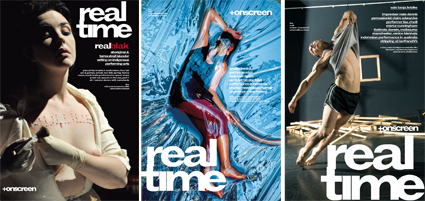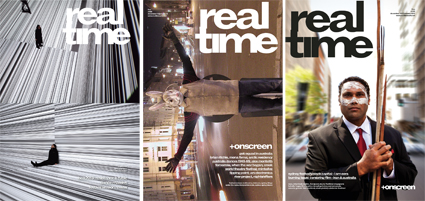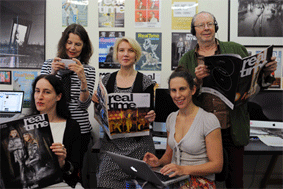RealTime, celebrating the second decade
Keith Gallasch, Virginia Baxter: RealTime 2004-14
 We’re exhilarated. We’re dispirited. Here we are celebrating 20 years of RealTime’s support for adventurous Australian art. “Exhilarated” at the thought of artists’ prodigious output, ceaseless inventiveness, resourcefulness and increasing connectedness across the nation. “Dispirited” because the previous Labor Government’s promised increase of mostly new cultural funding, $263m over four years, will not be realised by the new Coalition Government.
We’re exhilarated. We’re dispirited. Here we are celebrating 20 years of RealTime’s support for adventurous Australian art. “Exhilarated” at the thought of artists’ prodigious output, ceaseless inventiveness, resourcefulness and increasing connectedness across the nation. “Dispirited” because the previous Labor Government’s promised increase of mostly new cultural funding, $263m over four years, will not be realised by the new Coalition Government.
Instead, current funding levels for the Australia Council, Screen Australia, ABC and SBS will be radically cut. Worse, the hard-fought Creative Australia National Cultural Policy, the first new vision for the arts in 20 years, will doubtless be disappeared from public view. Worst of all, the independent artists who have been the principal subjects of our coverage will be the most disadvantaged by the cuts—the budget papers dictate that only forward-committed grants (eg for triennially-funded organisations) be maintained (see p15), guaranteeing that artists join the poor, the Indigenous, people with disabilities, the un-well, single parents, the unemployed and many others as the targets of Prime Minister Tony Abbott’s cold-blooded ideological assault. His nostalgia for Knights and Dames, his implementation of Sovereign Borders (headed by a General), his commitment to John Howard’s Intervention (realised first by the Army) and his passion to have “a hands-on, practical, grassroots environmental action” Green Army ($525m) of the unemployed fill out a self-portrait of Abbott as the great Culture Warrior.
One thing of which we are absolutely certain from 20 years of observation, and something we ourselves experienced making performance and creating the magazine, is that culture is not created top-down. Yes, artists are patronised, rewarded, funded and appropriated by those in power, but they make new art, new forms and new ideas that regenerate and challenge the status quo, mostly quietly, sometimes loudly. Without them, major arts organisations stagnate. Look no further than the last decade in which artists from small theatre ensembles and contemporary performance groups around Australia have worked their way into major theatre programs abetted by a few artistic directors who recognised real creativity or aided more recently by those who in acts of apparent beneficence, like MTC’s NEON seasons of independent works, fanfare their belated embrace of the new. This is not to say that major organisations cannot be innovative: we certainly review works and events where we think they’re pushing at boundaries, but we know where that creativity has come from.
For over two decades we have witnessed the emergence into prominence of many young artists who often received their first media attention on the pages of RealTime. But the path to success has not been easy: grants are often smaller than they were in the 1980s and 90s and certainly worth less in real terms. For example, with rising venue and production costs performance seasons for small companies have become almost ridiculously short providing few opportunities for works to mature. Advertising costs have soared if compensated for somewhat by the rise of social media, and not a few artists have turned to rapidly multiplying, intensely competitive crowd-funding schemes. On the other hand, development programs and co-productions with arts centres and touring possibilities are greater than ever before.
As artists poured out of the tertiary education sector annually in their thousands, the Labor Government channelled many millions into small Artstart grants, up to $10,000 each for university or TAFE graduate artists. But where were they to go once they’d benefited from travelling, researching, forming partnerships and creating an ‘arts business’? Apply for diminishing funding? Fight for space in inadequate arts infrastructure? At least the shortage of arts funding was acknowledged by Labor Arts Minister Simon Crean in 2013 promising new cultural funding of $263m over four years including $75m to the Australia Council.

There have been valuable infrastructure developments across the decade: for example the Mobile States touring program operated by Performing Lines for a consortium of enlightened arts centres and organisations. There’s the MAPS program developed between the states and the Australia Council for arts agencies to work with small groups of artists and companies to facilitate touring and to relieve management pressures. The Australia Council funded emerging producers for several years. On the international front, the linking of Australia with IETM, a European organisation committed to the exchange of ideas and the sharing of visions rather than simply marketing works, has been developing steadily over recent years, culminating in the Asian Satellite meeting recently in Sydney and Melbourne with attendees from across the country and overseas. In line with these developments, something we have noted is a greater entrepreneurial spirit in young artists, doubtless born of necessity but also putting to good use the networks they have built or which are offered them. We marvel at their survival and successes.
State government cultural policies and budgets are large determiners of the state of the arts in Australia (they provide at least 60% of all funding). The horrendous slashing of the arts budget in Queensland, cutting adrift youth arts organisations and MAAP (Media Art Australia Pacific) among others creates a nasty precedent for other states to follow suit, especially now that the Prime Minister has made clear his intentions. We suspect however that most states have learnt that their own voters are not inclined to see the arts punished. We live in hope.
From contemporary performance to live art
Hybridity, the impetus for our creation of RealTime, is evident these days across the arts from mainstream to marginal. Dominant artforms remain intact but are no longer the same having more or less effectively absorbed other forms, new technologies, engaged more directly with live audiences as active participants, expanded their scope for collaboration and responded in myriad creative ways to their habitats.
Successful intercultural collaborations between white and black artists in theatre and performance have created some fascinating hybrids—too many to mention—in which conventional formulae are discarded. (Equally, as revealed in our RealBlak edition in October 2012, Indigenous artists wish to create and write about works in the performing arts that are their own, not subject to appropriation and respectful of their cultural protocols.)
In the 2000s European and UK arts festival directors like Maria Magdalena Schwaegermann (formerly of the Hebbel Theatre and Zürcher Theater Spektakel) and Helen Cole (In Between Time, Bristol) were some of the first to fully recognise the unique capacity of Australian artists to cross artform borders in ways only slowly acknowledged here and often resisted in Europe. Where are we now that contemporary performance (version 1.0, My Darling Patricia, post, Branch Nebula and others) and independent theatre (The Hayloft Project, Black Lung et al) have found increasing mainstream attention? Contemporary Performance continues to be a force with new companies emerging and doing things in new ways. But a significant change is embodied in the slow but sure rise of live art in Australia.
Our RealTime residency at In Between Time in 2006 alerted us to just how extensive the development of Live Art was in the UK. We had known about it through LADA (Live Art Development Agency, London), Glasgow’s National Review of Live Art and New Moves International; Brisbane Powerhouse Artistic Director Zane Trow’s 2002 National Review of Live Art event in partnership with New Moves International; and The National Review of Live Art, Midland, Perth, 2005. These early efforts to engender the form in Australia simmered away until various artists began to come together through a range of events. We came home from Bristol forecasting live art’s emergence in Australia. It was often low budget (invaluable with ever shrinking funding) and highly portable, a wild mix of forms and a DIY mentality and opening performance to all kinds of practitioners—artists or not.
We were about to witness a new wave of hybrid practices and inventiveness. Enlightened Australian arts centres and organisations saw live art coming and ran with it. Stephen Richardson at Melbourne’s Arts House programmed it (with visiting UK artists) and made it part of Culture Lab. At Performance Space, Fiona Winning produced the Liveworks festival. Daniel Brine, a former staffer at LADA, followed her as director and pushed it further, encouraging site work. Jeff Khan’s two Next Wave Festivals demonstrated a multitude of the form’s unpredictable possibilities. Jude Anderson’s PUNCTUM in Bendigo, The Castlemaine Festival and the Regional Arts National Conference Kumuwuki/Big Wave, in Goolwa (SA) in 2012 all revealed that live art was not the exclusive province of urban artists. Exist-ence in Brisbane and other cities brought together performance art and live art while in Sydney PACT’s Tiny Stadiums and Underbelly increased live art’s visibility. Performance Space has taken it outdoors in Micro-Parks, Emily Sexton’s Next Wave embraces live art, and Perth’s PROXIMITY Festival is a feast of one-on-one live art engagement. The high point has come with Angharad Wynne Jones at Arts House instigating a biennial Festival of Live Art (FOLA).
Just how far live art will reach in terms of sustainability and influence is hard to predict. It has infinitely less box office earning capacity than contemporary performance which for the most part has hybridized the theatrical experience. It certainly has the potential to be widely experienced and to provide creative models for a new generation of artists and not just those from the performing arts. There are physical games where the artist does not appear, but simply provides instructions. The audience is increasingly becoming direct participant, collaborator, maker and performer, indeed the subject of many works where their senses, perception and judgment are tested. The sensory and physical dimensions of these experiences provide a welcome antidote to the principally visual world of the screen—something that the most innovative of digital artists likewise challenge.

The RealTime team, 2014: standing, Virginia Baxter, Gail Priest, Keith Gallasch, seated Katerina Sakkas, Felicity Clark
photos Heidrun Löhr
The RealTime team, 2014: standing, Virginia Baxter, Gail Priest, Keith Gallasch, seated Katerina Sakkas, Felicity Clark
What about us?
RealTime has grown substantially in its second decade, rolling another 60 bi-monthly editions off the presses and mining our considerable cultural capital to produce additional print publications and freely accessible online archives rich in the history of two decades of innovative practices. We produce more and more content with the same two full-time staff and three part-timers across the decade. Madness. But all of us are artists, quite un-alienated from our labours in art, writing, editing and producing RealTime. Constantly engaging with art that plays with perception, intensifies sensation and sidetracks judgment makes it all worthwhile. As do invitations to arts festivals to conduct writing workshops around the country and overseas from Bristol to Vancouver to Jakarta to Darwin (see p16).
It’s been our great pleasure to witness the growth of inner city, suburban and regional arts centres with their often inspiring programs, supporting and cutting across artform practices. Regional artists can no longer be regarded as the poor relations of city practitioners, as our coverage of the Riverina continues to reveal. We’re inspired by the creations of artists with disabilities. We admire those artists who are turning their media art-science works into interactive tools for palliative care and pain relief. We are impressed by artworkers like Kim Machan in her continued efforts to keep Australian media arts in the loop in Asia. We are excited by the growth of national touring and networking, barely evident a decade ago, allowing us to see more works once at a great distance from us—except on the pages of RealTime. We pay tribute to ADT, Lucy Guerin Inc, Circa and many others who represent the inventiveness of our culture overseas.
We worry about diminishing studio hours for artist students in our universities and the threat to their careers by a new government so wary of art. We lament the limited engagement in the arts between Australia and Asia. Much goes on, often quietly as with Asialink and 4a, or in the shape of the Asia Pacific Triennial and the Adelaide Festival Centre’s OzAsia (defunded in the Abbott-Hockey budget) and a variety of funded programs and in the ongoing work of Rosemary Hinde. But for the greater public, Asian art is still something you might encounter in an art gallery or occasionally in an arts festival.
Doubtless we’re in for tough times, but artists will fight to keep our heads above the rising sea levels denied by the Abbott Government.
Our thanks go above all to Gail Priest, our Online Producer and, for many years, Associate Editor, a great collaborator and friend. Thanks too to Felicity Clark, our administrative assistant, Katerina Sakkas in advertising sales, previous online producers Josephine Skinner and Caroline Wake, assistant editors across the decade Michelle Moo and Mireille Juchau, and Graeme Smith who created the first design for RealTime and continues to re-invent our look.
Particular thanks go to our Board of Management: Tony MacGregor, John Davis, Julie Robb, Philippa McGuiness and Urszula Dawkins and former member David Young. We always look forward to our meetings with them and appreciate their encouragement, not least in these challenging times for publishing. Special thanks to our many wonderful writers across Australia (some have been with us 20 years, some this edition), advertising clients, the Australia Council, Arts NSW, our sponsor, Vertel, and above all our readers.
For the next 20 years, whatever it takes!
Keith and Virginia
RealTime issue #121 June-July 2014 pg. 4-5






